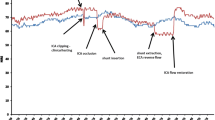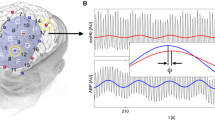Summary
Different methods have been used in the evaluation and monitoring of the cerebral oxygen supply during neuro-interventional therapies. Attenuation of near-infrared light by the chromophores oxyhemoglobin and deoxyhemoglobin have shown to be useful in the study of the cellular oxygen metabolism and oxygen delivery to the brain. Transcranial cerebral oximetry (TCCO) has the advantage of providing real-time information regarding regional brain oxygen saturation (rSO2) by using wavelengths in the near-infrared range.
We present a patient with a carotid cavernous fistula who underwent balloon occulusion and concurrent continuous TCCO monitoring. TCCO was found to be a useful tool providing immediate rSO2 values during the angiographic and interventional procedures. Initial balloon occlusion of a carotid cavernous fistula resulted in partial occlusion of the internal carotid artery lumen causing an immediate decrease in rSO2 which correlated with angiographic findings. Subsequent reocclusion of the fistula produced a slower and smaller degree of decrease in rSO2 with clinical improvement in the patient. Changes in rSO2 were detected before any adverse clinical event was observed. TCCO was reliable, safe, sensitive, and provided a real-time assessment tool for the monitoring of brain oxygen supply in a patient undergoing a neuroendovascular procedure.
Similar content being viewed by others
References
Ausman JI, McCormick P, Stewart M, Lewis G, Dujovny M, Balakrishnan G, Malik GM, Ghaly RF (1993) Cerebral oxygen metabolism during hypothermic circulatory arrest in humans. J Neurosurg 79: 810–815
Carta F, Ferrari M, Giannini I (1987) Inside a quantitative analysis of in vivo near infrared monitoring. Adv Exp Med Biol 215: 275–282
Dujovny M, Lewis G, Vinas F, Ausman J, Silva P, Flemming JE (1992) Cerebral oxygen saturation as a function of age, sex, and skin color. SPIE Proc 1641: 126–132
Dujovny M, Slavin KV, Geremia GK, Ausman JI (1994) Use of cerebral oximetry to monitor brain oxygenation reserves for skull base surgery. Skull Base Surg 4: 117–121
Dujovny M, Slavin KV, Lewis G, Cui W, Ausman JI (1994) Somanetics INVOS 3100 Cerebral oximeter. Instrumentation, technique, and technology. Neurosurgery 34: 935–936
Eggert H, Blazek V (1987) Optical properties of human brain tissue, meninges, brain tumors in the spectral range of 200– 900 nm. Neurosurgery 21: 459–464
Ferrari M, Zanette E, Sideri G, Giannini I, Fieschi C, Carpi A (1987) Effects of carotid compression, as assessed by near infrared spectroscopy, upon cerebral blood volume and hemoglobin oxygen saturation. JR Soc Med 80: 83–87
Horton B, Ziegler L, Adson A (1935) Intracranial arteriovenous fistula. III. Diagnosis and discovery of arterial blood in jugular veins. Arch Neurol Psychiat 33: 1232–1234
McCormick P, Stewart M, Goelting M, Dujovny M, Lewis G, Ausman JI (1991) Noninvasive cerebral optical spectroscopy for monitoring cerebral oxygen delivering and hemodynamics. Crit Care Med 19: 89–97
McCormick P, Stewart M, Lewis G, Dujovny M, Ausman JI (1992) Intracerebral penetration of infrared light. Technical note. J Neurosurg 76: 315–318
McCormick P, Stewart M, Ray P, Lewis G, Dujovny M, Ausman JI (1991) Measurement of regional cerebrovascular hemoglobin oxygen saturation in cats using optic spectroscopy. Neurol Res 13: 65–70
Mchedlishvili GI (1986) Cerebral arterial behavior providing constant cerebral blood flow, pressure, and volume. In: Bevan JA (ed) Arterial behavior and blood circulation in the brain. Plenum, New York, pp 55–60
Smith D, Levy W, Maris M, Chance B (1990) Reperfusion hyperoxia in brain after circulatory arrest in humans. Anesthesiology 73: 12–19
Williams I, McCollum C (1993) Cerebral oximetry in carotid endarterectomy and acute stroke. In: Greenhalgh RM, Kollier LH (eds) Surgery for stroke. Saunders, London, pp 129–138
Wray S, Cope M, Delpy D, Wyat JS, Reynolds EOR (1988) Characterization of the near infrared absorption spectra of cytochrome aa3, and hemoglobin for the noninvasive monitoring of cerebral oxygenation. Biochem Biophys Acta 933: 184–194
Author information
Authors and Affiliations
Rights and permissions
About this article
Cite this article
Dujovny, M., Slavin, K.V., Luer, M.S. et al. Transcranial cerebral oximetry and carotid cavernous fistula occlusion. Acta neurochir 133, 83–86 (1995). https://doi.org/10.1007/BF01404954
Issue Date:
DOI: https://doi.org/10.1007/BF01404954




